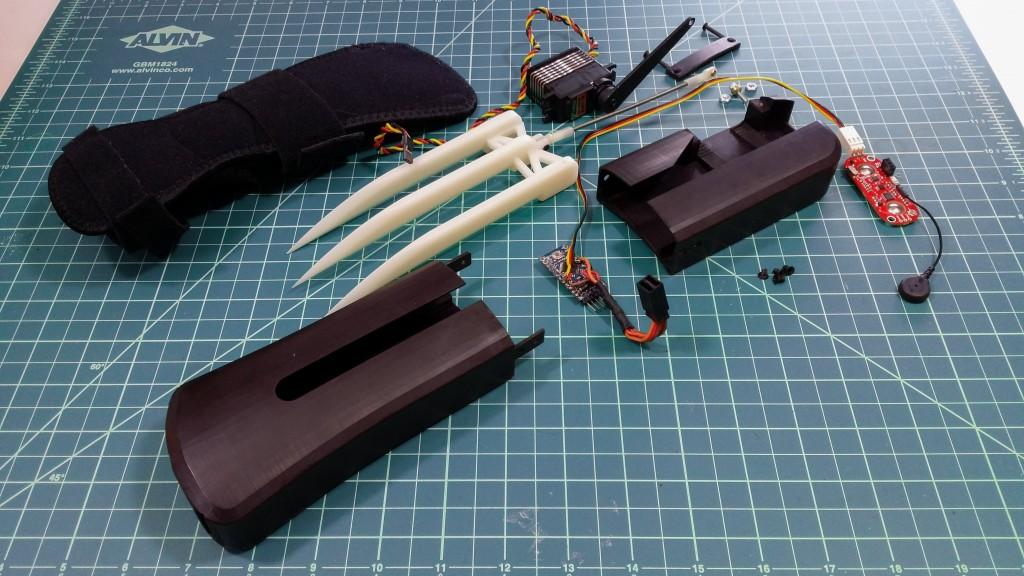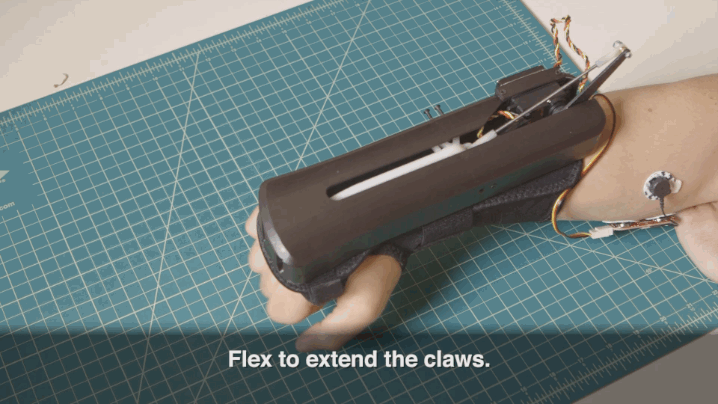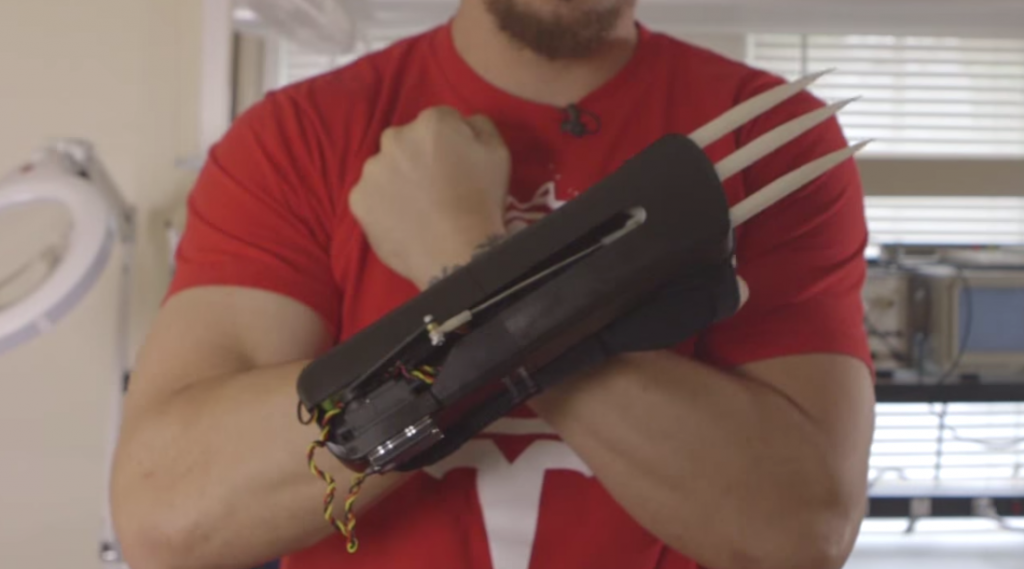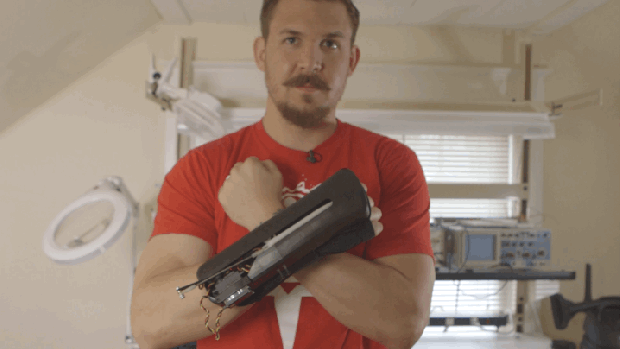I have seen working tools 3D printed in space. I have seen 3D printed brain tissue develop neurons that fire just like a real brain. I have seen a 3D printed car be assembled and then driven off within a matter of hours. But today, I have seen working Wolverine claws that pop in and out based not on a secret button or a trick, but rather in response to signals from a person’s body. This is it. It really isn’t going to get much better than this, so it is probably time to pack up all of our toys and go home. Let’s be honest, the 3D printing industry is probably not going to ever top this achievement.
MyoWare is an Arduino compatible sensor that reads the electrical impulses from your muscles and can convert those impulses into commands for robotics, games and prosthetic devices. The MyoWare isn’t new technology, it was actually developed way back in 2011 by Brian Kaminski and his company Advanced Technologies, however it was a lot bulkier and harder to use back then. When he made the third generation available to the public, it was a big success in the maker community. It was used primarily for prosthetic limbs and devices, most famously in an Iron Man themed prosthetic device that was presented to a 7 year old kid by Robert Downy Jr himself.
This is awesome, and adorable and everything, so consider my emotions sufficiently moved. But did I mention that Kaminski used the cool new, advanced fourth generation sensor to make working Wolverine claws? The working claws were designed to help promote Kaminski’s new crowdfunding campaign on Kickstarter, to bring the newest MyoWare iteration to market. And of course, because it is always nice to give back, the campaign will donate one sensor to Limbitless Solutions (The charity behind the Iron Man prosthetic) for every five that are purchased by their backers. That is a lot of Iron Man prostheses.
To bring attention to the (actually a very cool) Kickstarter campaign, Make Zine published a tutorial showing readers how to 3D print their own set of working Wolverine claws. The tutorial includes links to all of the relevant components needed for the project, including the 3D printable files, a parts shopping list and easy to follow diagrams for the electronics and wiring required. Once assembled, the MyoWare sensor will pop and retract the claws just by flexing and relaxing your arm muscles. And if you want to pop the claws out and leave them out without needing to keep your arm flexed, just hold the flex for two seconds and a trigger lock mechanism will activate. In order to retract the claws again, simply flex for two seconds again and relax, and they will pop back in.
 The way that MyoWare works is actually very simple. The sensor has been designed to exclusively read the electrical activity of the human body’s skeletal muscles. That is specifically the muscles that are controlled voluntarily or by making conscious decision to move or flex a muscle. When your brain tells your muscle to move, it activates the muscle fibers that create the force needed to move. The MyoWare sensor not only detects these signals, but it can read the strength of the signal, so the harder that you flex, the stronger the signal sent from the sensor to the attached device will be. This feature would be especially useful for a prosthetic hand for example, allowing the person wearing it to safely hold objects of different weight or fragility without worrying about breaking something delicate or dropping something heavy.
The way that MyoWare works is actually very simple. The sensor has been designed to exclusively read the electrical activity of the human body’s skeletal muscles. That is specifically the muscles that are controlled voluntarily or by making conscious decision to move or flex a muscle. When your brain tells your muscle to move, it activates the muscle fibers that create the force needed to move. The MyoWare sensor not only detects these signals, but it can read the strength of the signal, so the harder that you flex, the stronger the signal sent from the sensor to the attached device will be. This feature would be especially useful for a prosthetic hand for example, allowing the person wearing it to safely hold objects of different weight or fragility without worrying about breaking something delicate or dropping something heavy.
Here is a brief video of the claws in action:
Traditionally, manufactured prosthetics that incorporate similar biosensor technology can cost tens of thousands of dollars, pricing them well out of reach for most people. At only $35 dollars each, the MyoWare sensor is ideally suited to be incorporated into the type of low cost 3D printed hands made by charitable organisations like Limbitless Solutions and E-Nable. Assistance devices like these can literally change lives and facilitate an entire new level of independence. And now, hopefully if there is any justice in the universe, a disabled person can have a 3D printed arm prosthetic complete with retractable Wolverine claws. Make it happen Mr Kaminski. Seven year olds with Wolverine claws, what could possibly go wrong?
All joking aside, Both Limbitless Solutions and E-Nable are fantastic organisations that are doing amazing work and could really use your support. If you’re not a maker or have no need for a device like MyoWare but still want to help, the Kickstarter campaign even has an option to buy one of the sensors to be donated directly to Limbitless Solutions. You can sign our petition to have all seven year olds fitted with retractable Wolverine claws over on the Bionic 3D Printable Wolverine Claws forum at 3DPB.com.
Subscribe to Our Email Newsletter
Stay up-to-date on all the latest news from the 3D printing industry and receive information and offers from third party vendors.
You May Also Like
Changing the Landscape: 1Print Co-Founder Adam Friedman on His Unique Approach to 3D Printed Construction
Additive construction (AC) is much more versatile than it seems, at first: as natural as it is to focus on the exciting prospect of automated home construction, there’s far more...
US Army Corps of Engineers’ Megan Kreiger on the State of Construction 3D Printing
Despite last year’s gloomy reports about the financial state of the additive manufacturing (AM) industry, there’s no doubt that we’re actually witnessing the birth of a sector rather than its...
3D Printing Webinar and Event Roundup: April 21, 2024
It’s another busy week of webinars and events, starting with Hannover Messe in Germany and continuing with Metalcasting Congress, Chinaplas, TechBlick’s Innovation Festival, and more. Stratasys continues its advanced training...
Profiling a Construction 3D Printing Pioneer: US Army Corps of Engineers’ Megan Kreiger
The world of construction 3D printing is still so new that the true experts can probably be counted on two hands. Among them is Megan Kreiger, Portfolio Manager of Additive...






























